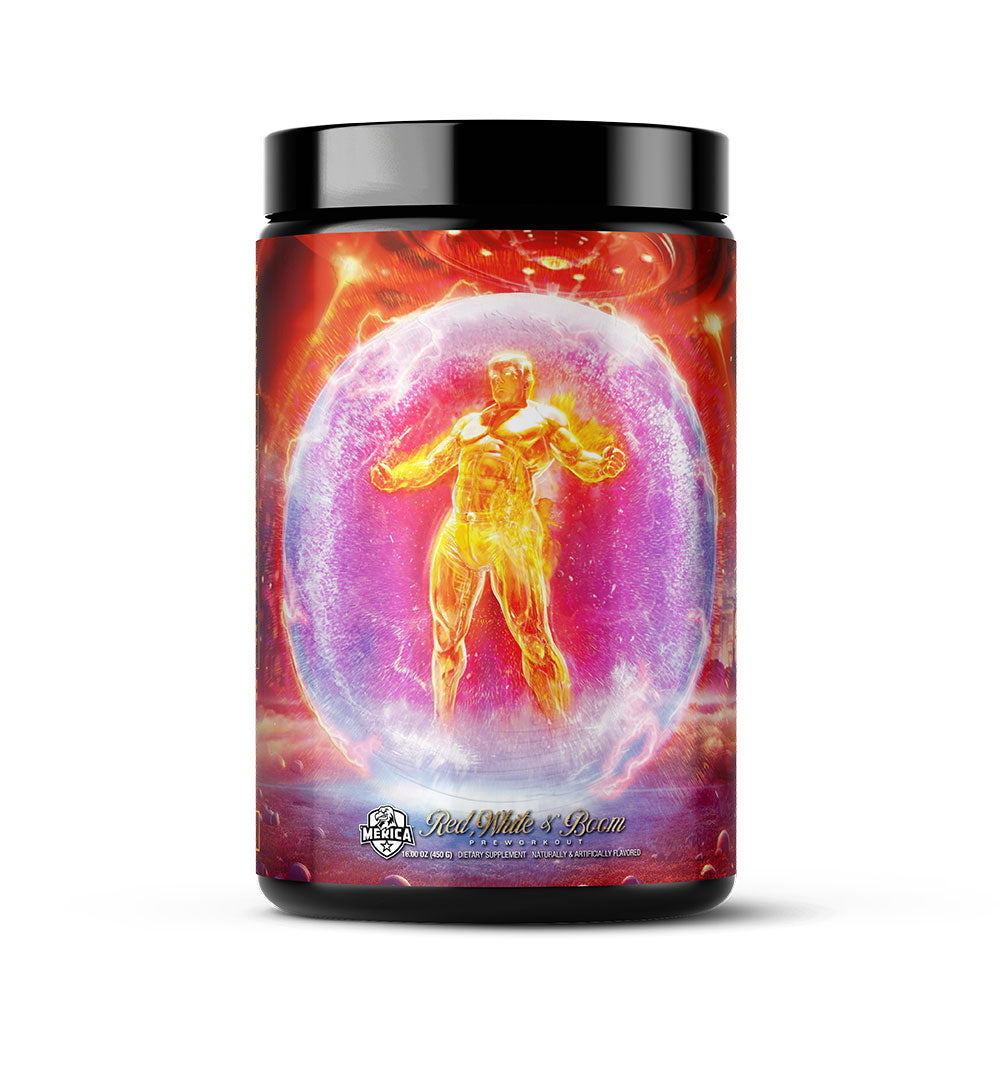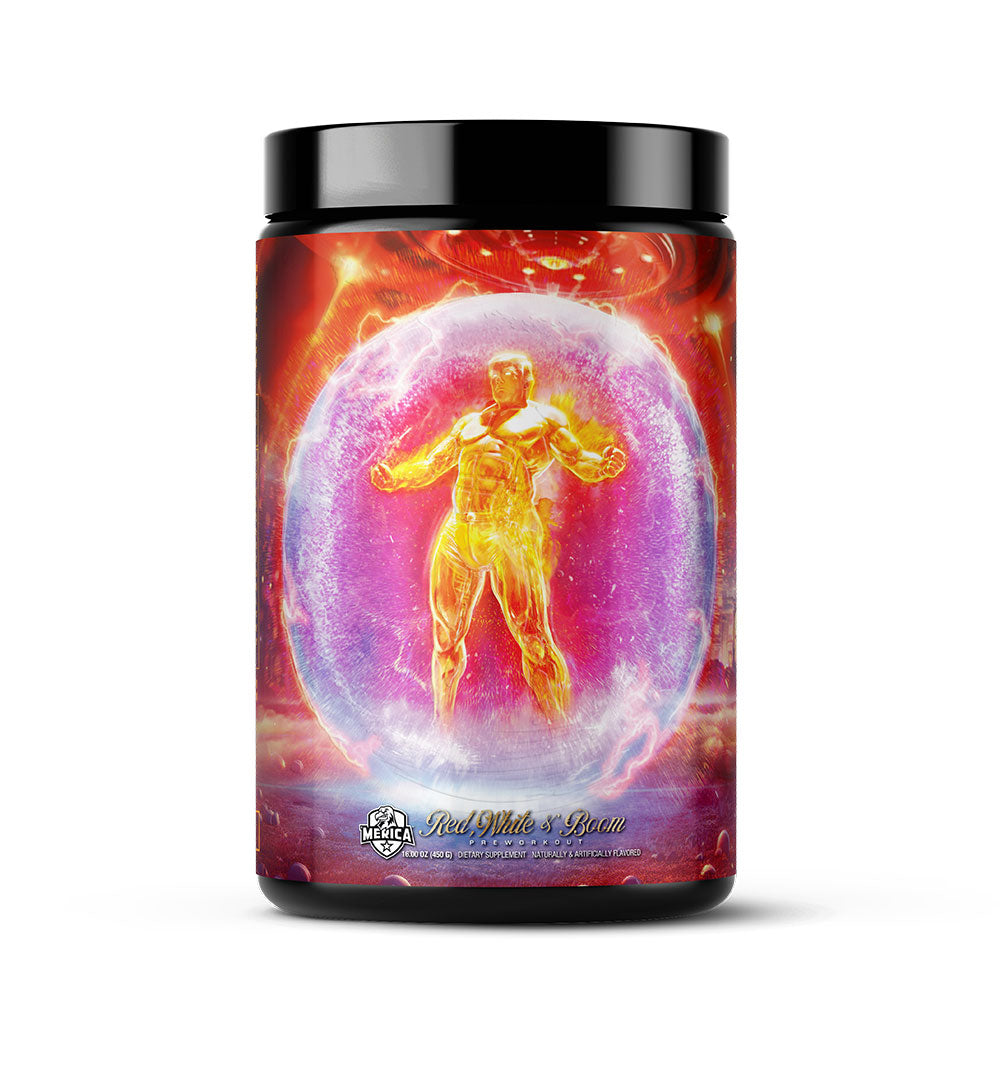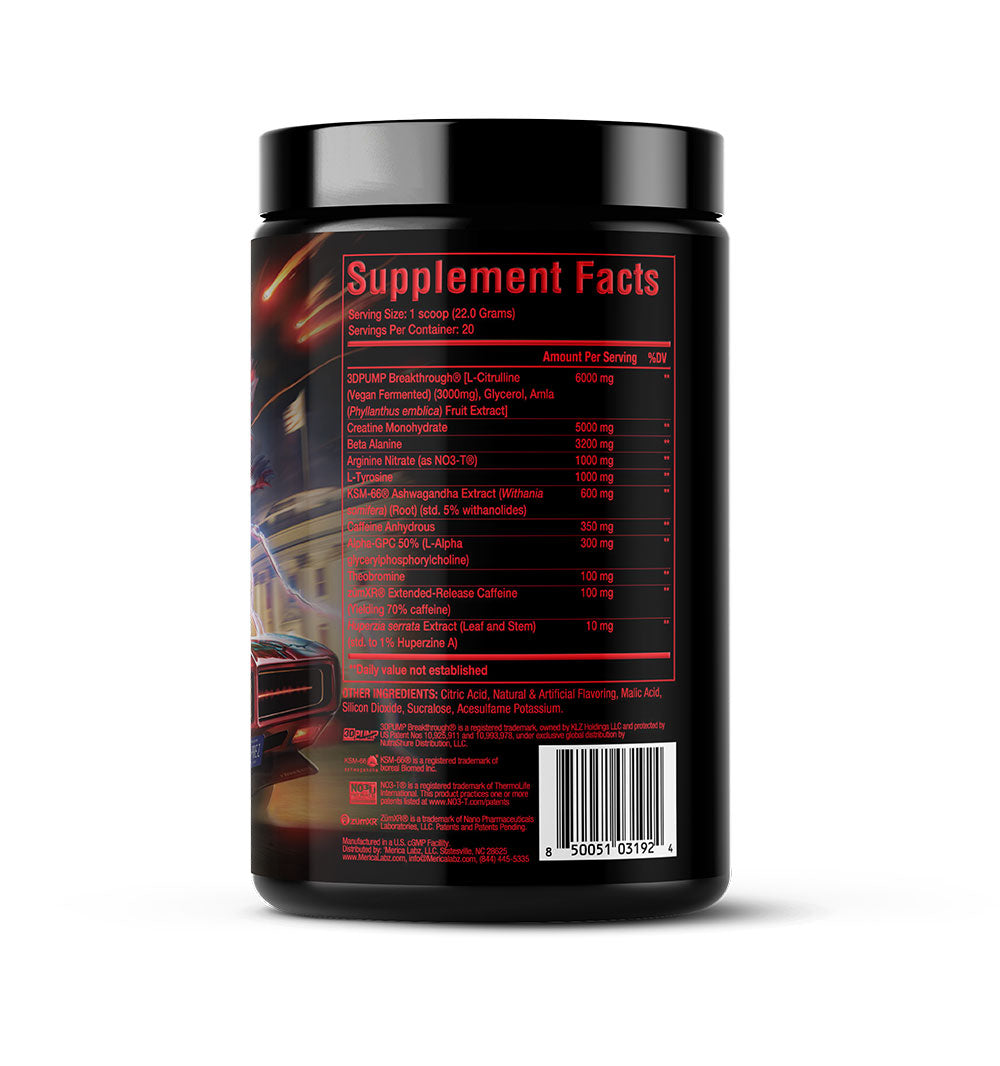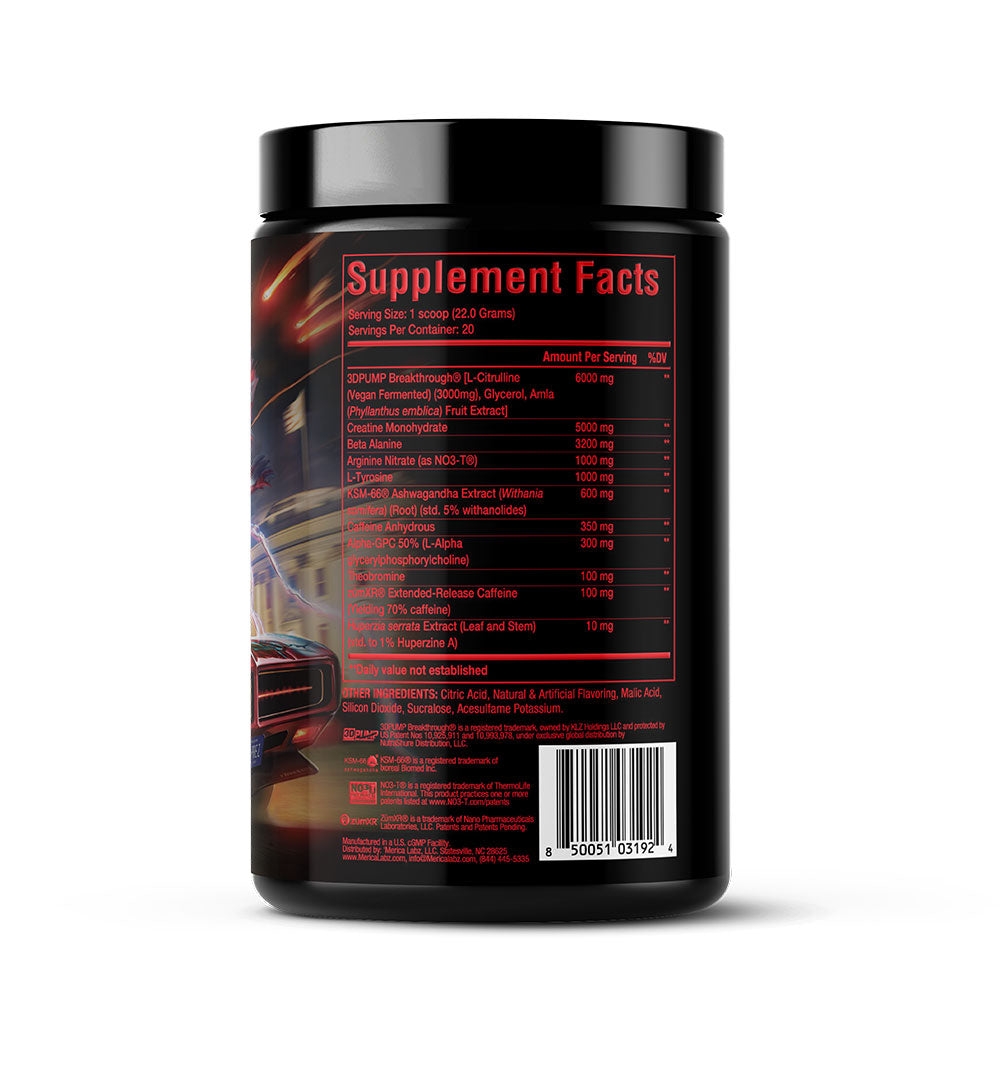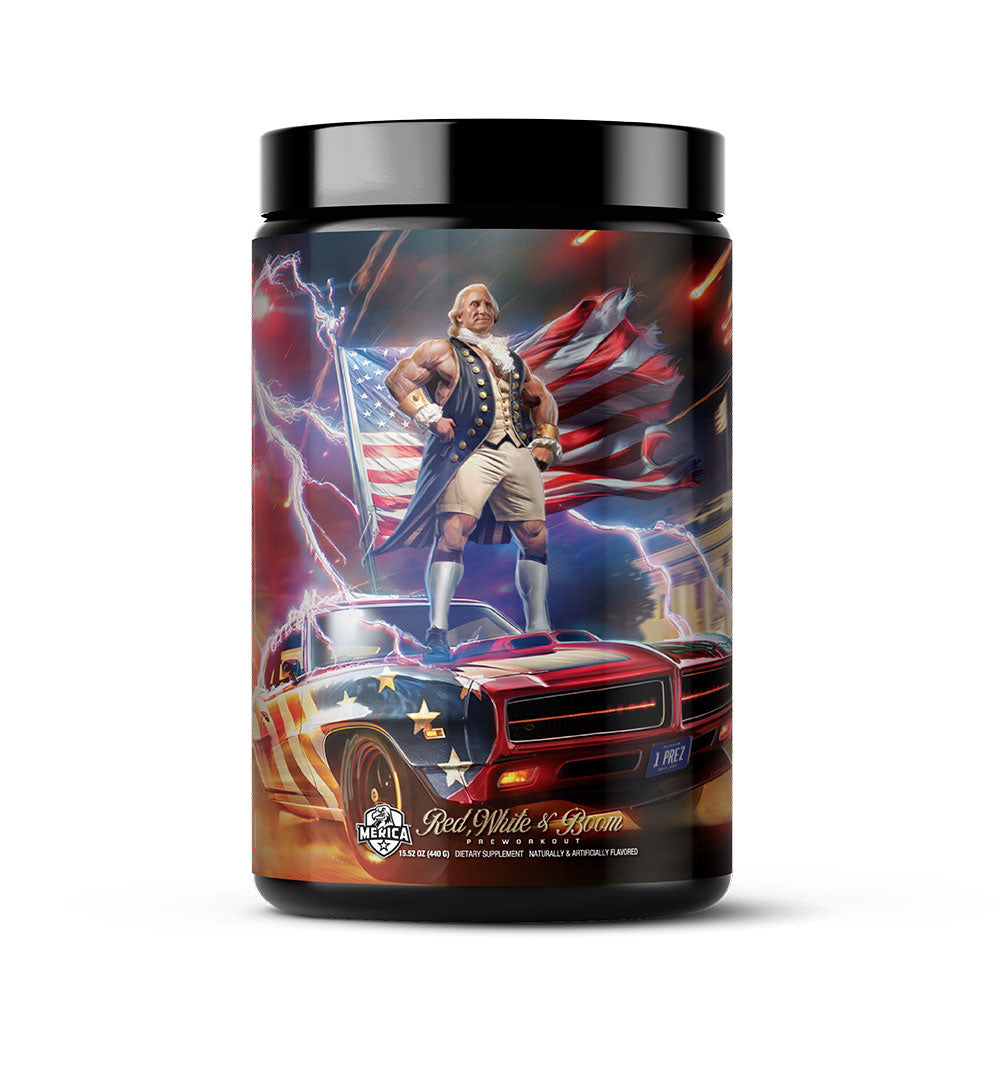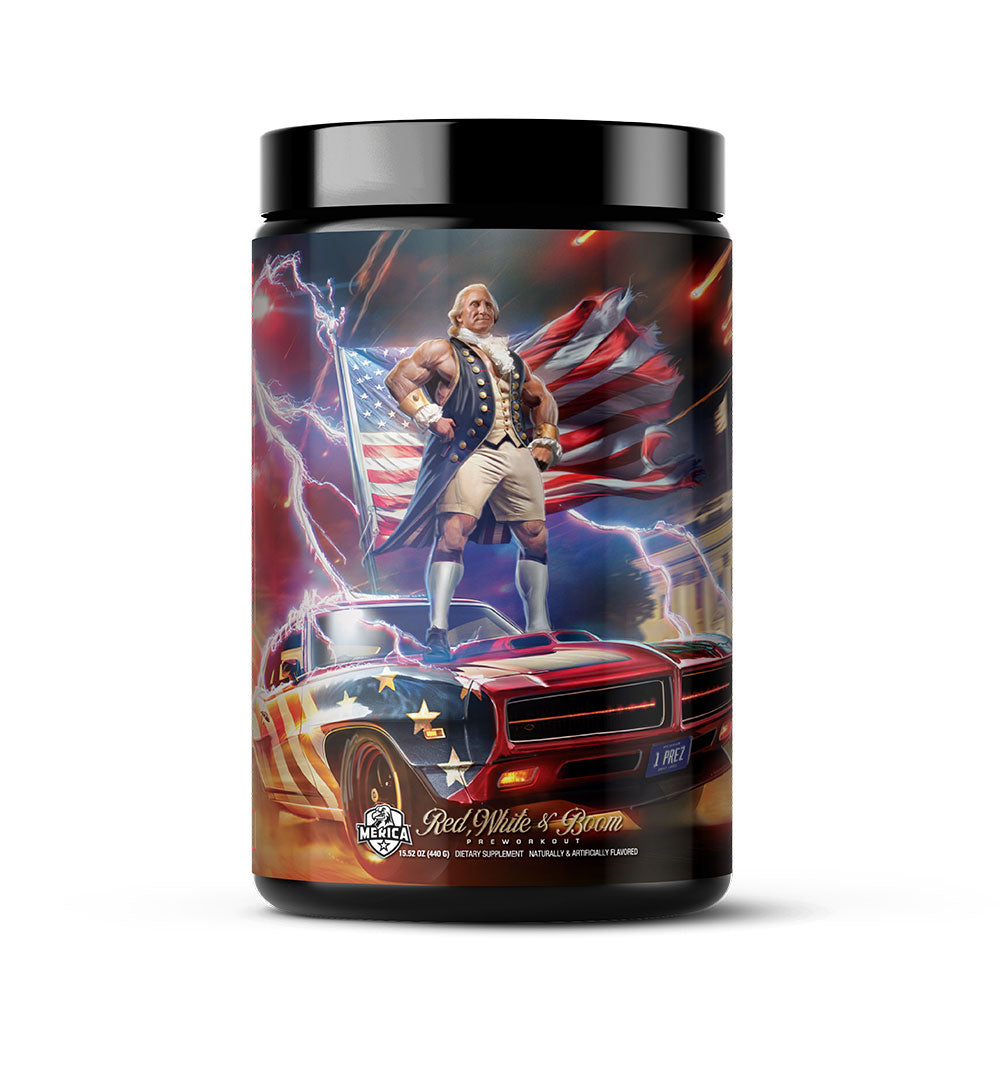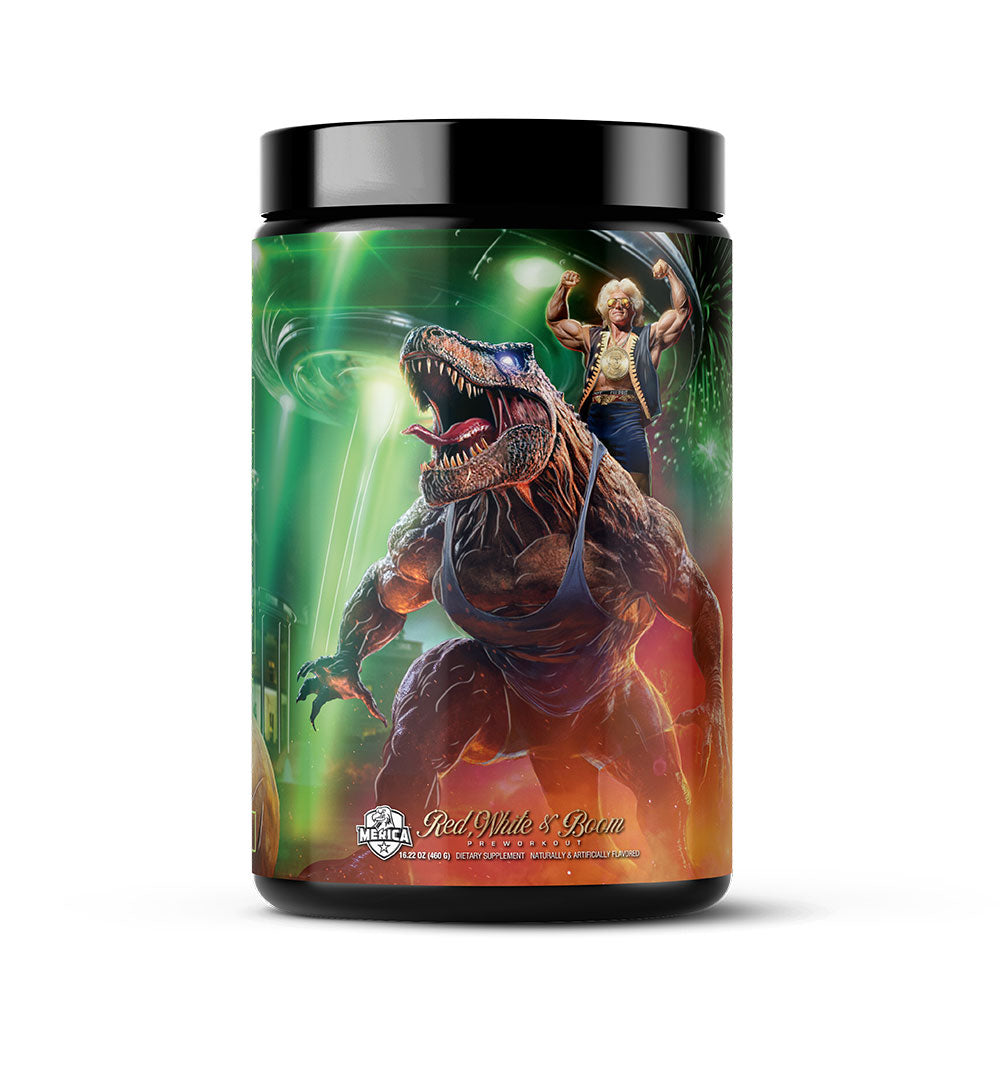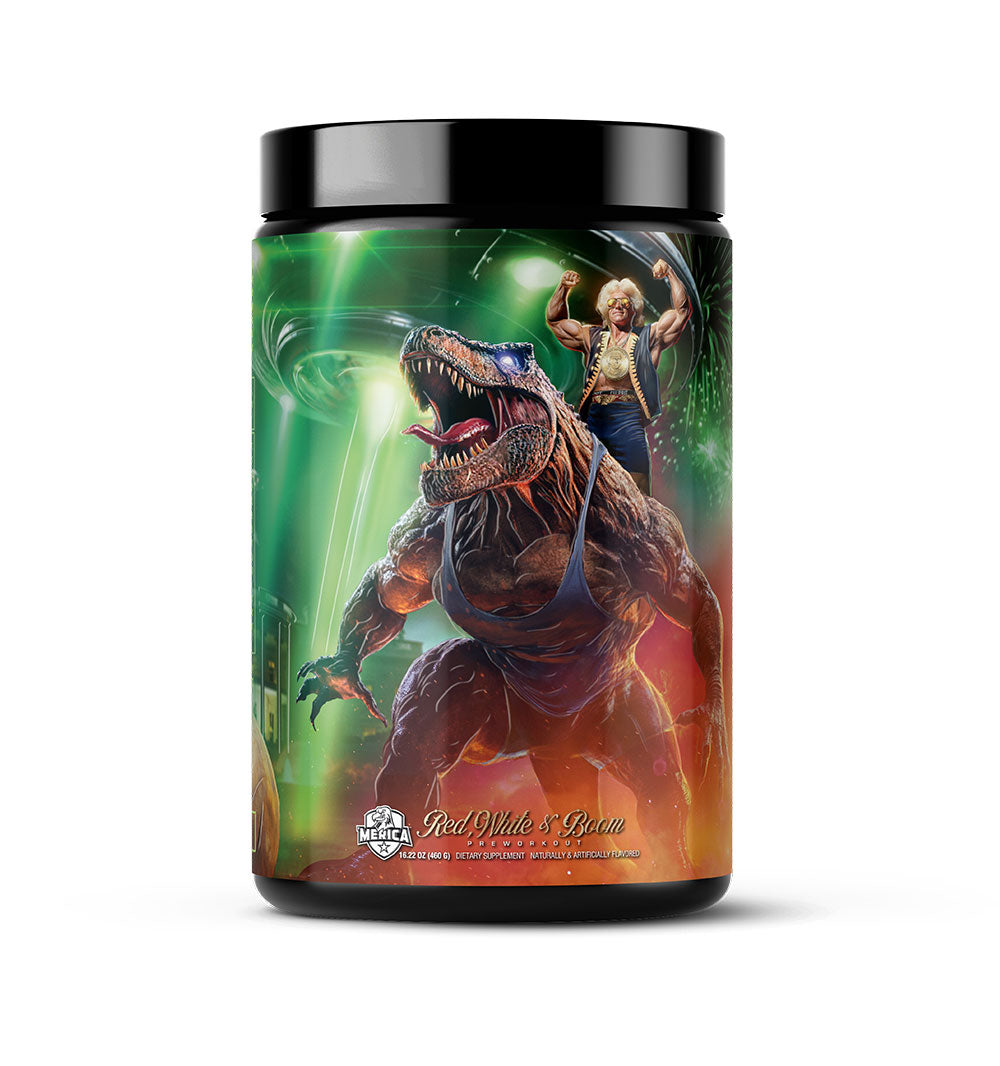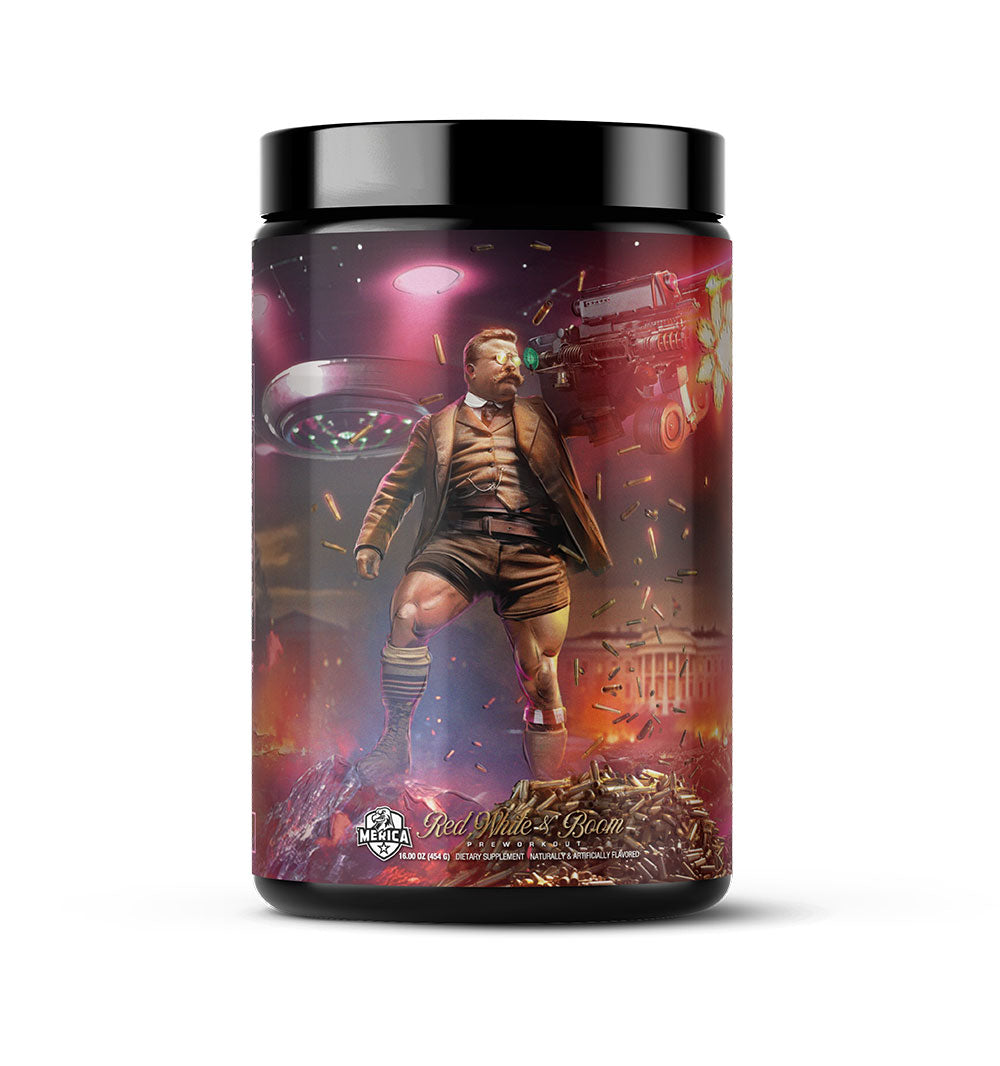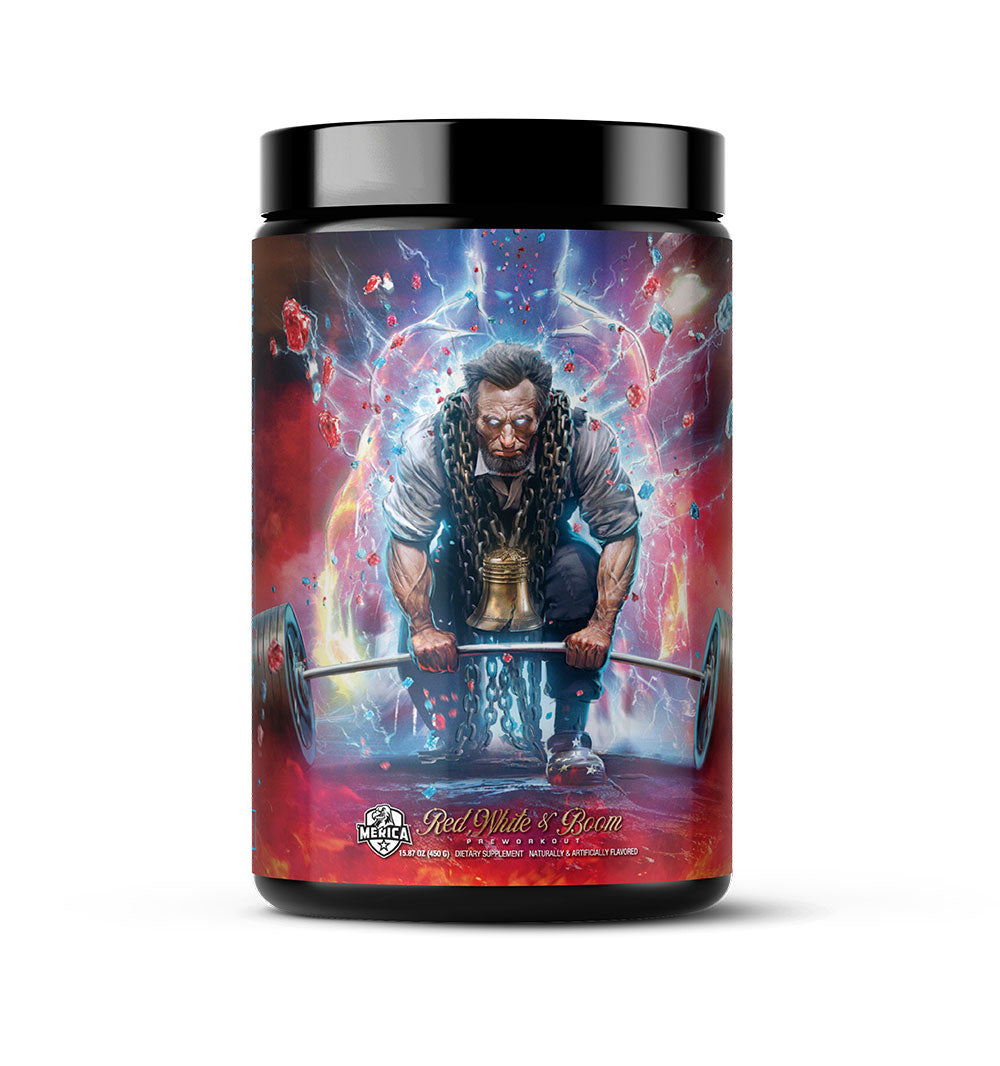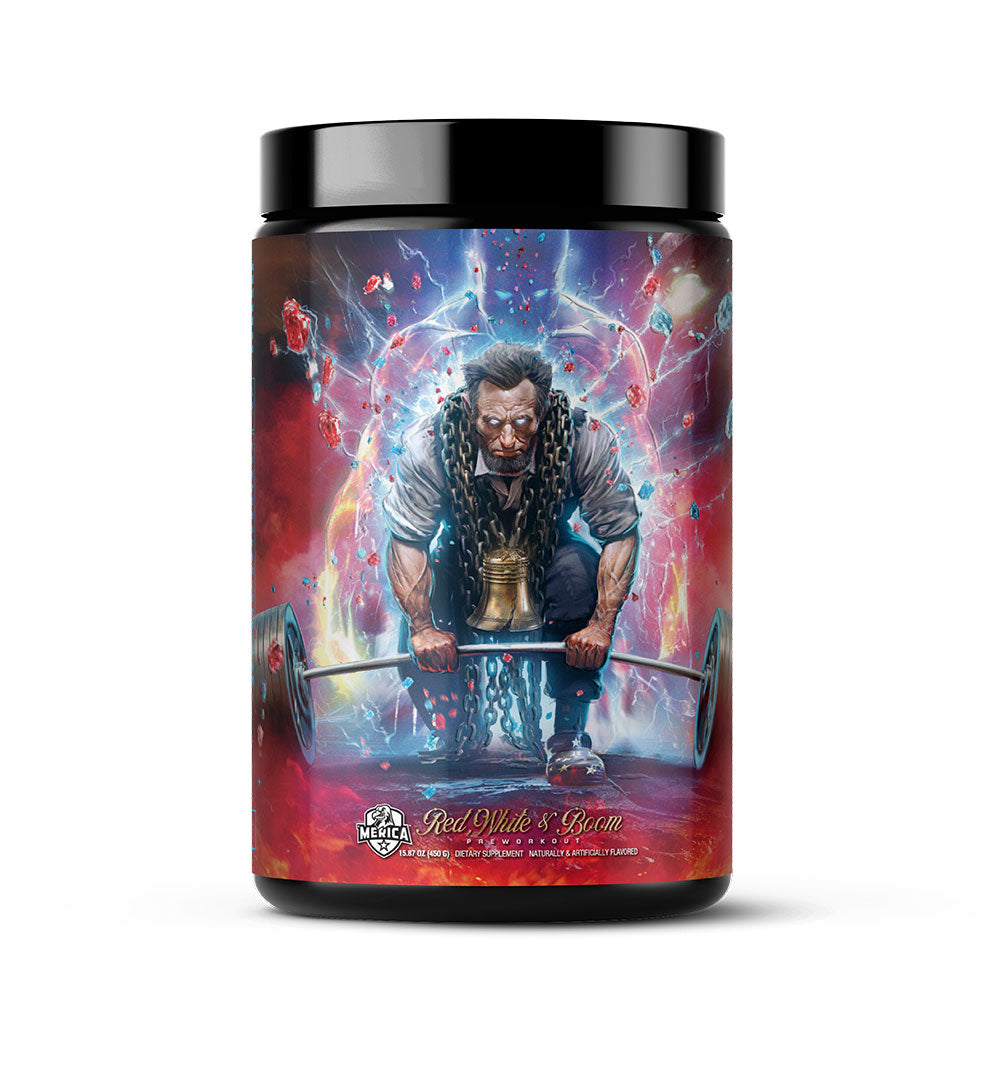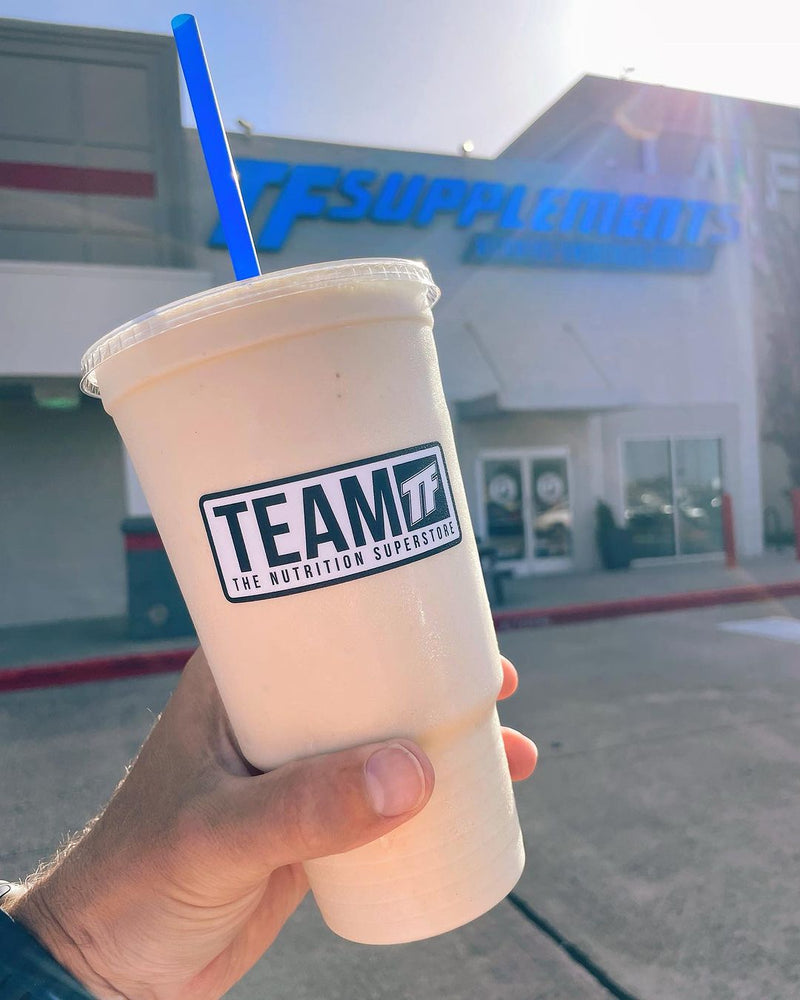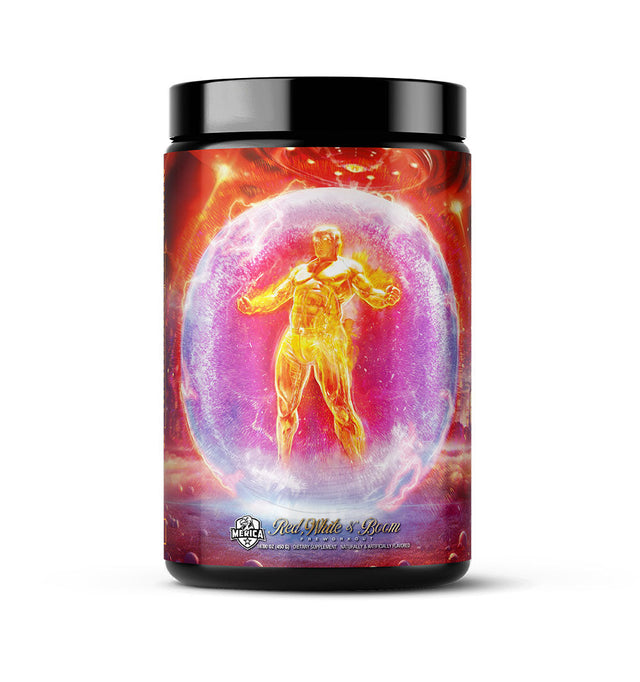'Merica Labz Red, White & Boom Pre-Workout
'Merica Labz Red, White & Boom Pre-Workout - Cherry Bootlegger is backordered and will ship as soon as it is back in stock.
Couldn't load pickup availability
Delivery and Shipping
Delivery and Shipping
Free U.S. Shipping Over $99 + a free bonus gift!
- Increased muscle pumps and exercise performance.
- Intense focus throughout your workout.
- Consistent and sustained energy.
- 100% 'Merican!
3DPUMP Breakthrough® [L-Citrulline (Vegan Fermented) (3000mg), Glycerol, Amla (Phyllanthus emblica) Fruit Extract]
3DPUMP Breakthrough® is a revolutionary new ingredient that is a patented combination of Fermented L-Citrulline, Glycerol (high yield), and a standardized extract of Amla Fruit. This ingredient supports increase vasodilation to the target muscle as well as improved endurance during training by utilizing complimentary pathways of action. If we break down each of these ingredients individually, we can begin to understand what makes this unique combination so beneficial.
- L-Citrulline - amino acid that converts to arginine and supports nitric oxide production, which aids blood flow and increase muscle pumps. Citrulline has also been shown to enhance exercise performance (particularly in resistance training protocols), boost power, reduce the onset of fatigue, and aid recovery.
- Glycerol - another common inclusion in pre workout supplements that serves as an osmolyte, which means it encourages muscle cells to attract and absorb more water. This increases cell volumization and cellular swelling, which not only enhances the pump but gives a full look to your muscles.
- Amla - has a long history of use in Indian medicine as a cardiotonic. It’s high in polyphenols and flavonoids (including pedunculagin, puniglucanin, emblicanin A, and emblicanin B) that are known to possess antioxidant activity and support cardiovascular health.
It’s common to find L-Citrulline and Glycerol amongst other nitric oxide and pump inducing ingredients with a track record of efficacy but the real question is if the addition of Amla enhances the experience. Studies have shown that this answer is undoubtedly yes! One study measured cell volumization and muscle swelling because of performing lower body exercises using multiple interventions, which included placebo, 1500mg glycerol, 150mg Amla, and 1350mg glycerol + 150mg Amla. The results showed that all interventions, including placebo, produced positive results on leg size and lean body mass, however, the glycerol + Amla produced significantly better results than the other interventions. The glycerol + Amla group increased their thigh circumference by 2.21 cm on average and had an increase of 693.1 grams in total body mass. These results make the combination of adding Amla to the already classic benefits of L-Citrulline and Glycerol extremely promising when it comes to making positive improves in your goals when it comes to sport performance products.
Creatine Monohydrate
Sometimes called the “grandfather” of dietary supplements, creatine is, along with caffeine, one of the most extensively studied dietary compounds. Certainly, it is the most well-studied ergogenic aid. Generally speaking, the extensive amount of data on creatine demonstrates that it positively contributes to dilation of the vasculature, plasma-nutrient mobilization, post-workout nitrogen retention and protein synthesis, along with dose-dependently increasing contractile force through ATP (adenosine triphosphate) provision (i.e., it helps support increased strength).
If the human body could be considered a bank account, then ATP would be the currency, and every cellular process would be like spending a little money from that account. Without making a deposit, the account runs dry (fatigue). Unfortunately, making a direct deposit to that account in the form of exogenous adenosine triphosphate is impossible, given that ATP itself is incredibly unstable. The use of supplemental creatine, however, is analogous to making a deposit in the body’s energy bank, given that creatine is eventually metabolized to ATP via several steps. In skeletal muscle, creatine is first phosphorylated into its primary derivative, known as phosphocreatine (PCr), by the muscle-specific creatine kinase, creatine kinase-MB (muscle-brain). Following the phosphorylation of creatine, phosphocreatine may then anaerobically donate a phosphate molecule to adenosine diphosphate (ADP) to form the ATP required during the initial stages of intense muscular contraction. The result is not only an increase in contractile force, but also an increase in potential type IIx (‘fast-twitch’) muscle recruitment – the type of muscle fibers which are not only traditionally associated with speed, strength, and impressive physiques, but which are also unsurprisingly the most energy-demanding fiber types. Literally speaking, creatine contributes to the building of muscle.
Both through the ATP provision just described, as well as effects on nutrient mobilization, protein-sparing, and fluid dynamics, creatine has been consistently demonstrated to increase both lean mass and muscle mass in clinical data. In the short-term, these effects are most likely the result of extra-cellular fluid retention normally associated with exogenous creatine use. In the long term, these effects are likely attributable to creatine’s collective effect on muscle metabolism. The most recent research on creatine suggests it exerts direct effects on muscle metabolism, including altering the expression of genes responsible for ribosomal assembly, attenuating the breakdown of leucine, and most famously, by expanding cell volume. Cutting through the jargon, let us just say that the amount of creatine monohydrate contained in Red, White, and Boom simply works: these servings have been shown time and again to significantly increase lean body mass and muscle volume, lower fatigue, and improve performance (measured in several ways).
Beta Alanine
Carnosine is a bit of an odd duck: we know that it is crucial for muscle function, and that dietary sources of caronsine are essential, but we don’t know precisely how it’s working. Moreover, for decades, we had no idea how to increase intramuscular concentrations, as exogenous carnosine sources degraded in the body so fast as to be effectively useless.
Enter beta-alanine. Simply a different iteration of one of the amino acids that comprises carnosine itself (alanine), beta-alanine has proven to be the most effective means of significantly increasing intramuscular concentrations of carnosine – and therefore of promoting all of carnosine’s various beneficial effects on muscle performance. If that weren’t enough, beta-alanine has also demonstrated beneficial physiological effects independent of its parent compound. In order to understand why, though, we need to first understand some of the basics behind carnosine itself.
Carnosine, a cytoplasmic dipeptide synthesized from the precursors L-histidine and l-alanine, is present in high concentrations in skeletal muscle and plays a pivotal role as a, “chemical buffer” in myocytes (muscle cells). It has long been known that carnosine concentrations are highest in glycolytic, rather than oxidative muscle fibers (roughly speaking, explosive vs., endurance muscle fibers, respectively), and thus long hypothesized that this amino acid is required for sustained performance during supramaximal exercise. Recent research demonstrates that carnosine exerts its physiological effects in long hypoxic (low oxygen) drives by functioning as a high-capacity pH buffer in skeletal muscle, preventing the pH ratio of plasma from dropping too low – and therefore preventing crucial pH-dependent processes such as protein synthesis from being inhibited by acidosis.
Despite its critical role in skeletal muscle anaerobic performance, intramyocellular synthesis of carnosine is rate-limited by the availability of l-alanine. Unfortunately, the majority of literature demonstrates that attempting to increase intramuscular levels of carnosine via either direct carnosine or alanine supplementation is largely ineffective due to carnosine/alanine pharmacokinetics. Enter beta-alanine. Research with beta-alanine demonstrates consistent and dose-dependent increases to intramuscular carnosine concentrations with beta-alanine supplementation, with certain studies showing an increase of 40-60% with chronic administration. These same literature reveal a synergistic effect of exercise on beta-alanine supplementation, whereby the muscle adaptive changes associated with resistance training promote further intramuscular carnosine production in response to beta-alanine supplementation.
In simpler language, this essentially means that beta-alanine is a dietary supplement that promotes its own effects in combination with exercise. As you exercise, you simultaneously intensify beta-alanine’s physiological actions – both directly, as well as in the production of intramuscular carnosine. Once ingested, beta-alanine’s exercise-specific beneficial activity is well-established. Elevation of intramuscular caronsine content via beta-alanine supplementation has been shown to improve performance in the following ways.
- Both acute and chronic increases in total work capacity, measured by total volume during exercise sessions.
- Highly significant increases to TTE (total time to exhaustion), one of the most accurate and comprehensive measures of endurance. In various trials, beta-alanine supplementation has been shown to increase TTE by upwards of 20%.
Increases to total muscle power output in both acute and chronic trials, suggesting that beta-alanine’s most significant benefit is to those engaging in power-dependent resistance training.
In total, a significant body of research exists to suggest that beta-alanine may significantly increase muscle power output, strength, training volume and output, overall performance in hypoxic (oxygen-deprived) conditions and peak VO2 max (oxygen holding capacity).
These myriad benefits make beta-alanine both one of the most-studied, and most well-rounded dietary supplements. Beta-alanine not only has direct, actionable physiological effects, but also promotes critical muscle physiologic adaptations that promote its own effects.
Arginine Nitrate (as NO3-T®)
Nitric oxide (NO) is involved in many vascular and cellular functions as a signaling molecule for cellular respiration, vasodilation, and angiogenesis. NO is produced through both endogenous and exogenous pathways through dietary nitrate ingestion. Nitrates are converted to nitrite, which is then converted to nitric oxide. Found naturally in many foods such as leafy greens and beets, NO has a long history of scientific literature to back its potential effects as an ergogenic aid and other health-promoting effects. In terms of athletic performance, NO typically will make an impact through a few different mechanisms, such as:
- Delayed onset of fatigue
- Increased nutrient and oxygen delivery to working muscles via increased vasodilation
- Increased loss of metabolic by-products because of high intense exercise
However, when it comes to exercise and utilizing NO for its benefits in athletic performance, consuming whole foods is not always the most optimal form, so dietary supplemental forms of nitrates are often used to help provide this benefit. There are several forms of supplemental nitrates on the market today but for Red, White, and Boom we are utilizing arginine nitrate (NO3-T®). Arginine nitrate is a salt that is synthesized from adding nitric acid to arginine. Arginine is classically utilized for its blood flow and vasodilation improving benefits and when combined with a nitrate, these benefits get exponentially elevated. As discussed above, the pathways with which NO is produced are of the importance. Pairing arginine with the patented nitrate (N03-T®) enhances nitric oxide production via the nitrate-nitrite pathway. Organic nitrate esters have a direct relaxant effect on vascular smooth muscles through non-nitric oxide synthase pathways, being directly converted first to nitrites and then to nitric oxide itself. (With attendant increases to guanylyl cyclase and then cyclic guanosine monophosphate (cGMP), which relax the vasculature.) Pairing both nitric oxide synthase and non-nitric oxide synthase-dependent mechanisms of actions theoretically enhances total NO production, given that rate-limiting enzymatic pathways in either mechanism do not determine total NO production.
In an absolute sense, both inorganic and organic nitrates also possess benefits beyond a secondary NO-production pathway. Studies in athletes have demonstrated that nitrate ingestion prior to both aerobic and anaerobic exercise meaningfully increases both delay to fatigue and total work capacity – likely a consequence of nitrate’s activation in hypoxic (oxygen-deprived tissues). Nitrate effectively reduces the oxygen cost of muscular activity, making contractions more efficient.
L-Tyrosine
Tyrosine is amongst a class of amino acids known as ‘non-essential’ amino acids, so called because the body can produce them endogenously, and it is therefore not essential to consume dietary tyrosine. That said, tyrosine is also what is known as a conditionally-essential amino acid; conditionally-essential because, along with glucose and ammonia, the synthesis of tyrosine additionally requires adequate levels of phenylalanine. Once synthesized, tyrosine is one of the most critical amino acids, given its prominent role as a substrate in the synthesis of the catecholamines dopamine, norepinephrine, and epinephrine, in addition to both T3 (triiodothyronine) and T4 (thyroxine) thyroid hormones.
In studies on stress modulation, tyrosine has been demonstrated to reverse stress-induced norepinephrine depletion and the depressant-behavioral effects normally associated with it. In simpler terms, tyrosine may, in certain conditions, dampen the extent to which norepinephrine is removed from the bloodstream during a stress event. In simpler terms still, tyrosine may help to mitigate the sense of depletion and fatigue felt at the end of a workout.
Tyrosine may also play important metabolic functions, mostly related to its role in synthesizing compounds which stimulate the nervous system. While not traditionally considered a sympathomimetic amine, studies which have coadministered tyrosine and stimulants demonstrate a synergistic effect. These studies suggest that tyrosine may potentiate the effects of both endogenous and supplemental norepinephrine and its mimetics (in the case of exogenous use) with respect to lipolysis, thermogenesis, and energy expenditure. Meaning that tyrosine may play a role in assisting norepinephrine to break up triglycerides and increase body heat transiently.
KSM-66® Ashwagandha Extract (Withania somnifera) (Root) (std. 5% withanolides)
Withania somnifera Dunal, colloquially known as Winter Cherry or Indian Ginseng, is an herb that features prominently in the traditional Indian medicinal system of Ayurveda. Known as Ashwagandha in Ayurveda, Withania somnifera is a critical ingredient in various Ayurvedic tonics and tinctures prepared as a traditional remedy for the treatment of various ailments. Recently identified as a potent adaptogenic and target for therapeutic applications, Ashwaghanda has been the subject of numerous animals, pre-clinical, and clinical trials designed to examine its potential effects as an antioxidant, anti-carcinogenic, anxiolytic, antibacterial, antifungal, and immonumodulating compound. Ashwaghanda’s broad therapeutic potential is hypothesized to be the result of its robust phytochemical profile, including a wide swath of alkaloids, sitoindosides, and the highly biologically active withanolide group. As the principally biologically active compounds within Ashwaghanda, withanolides such as withanone, withaferine A, withanolides A, D, and G have been identified, isolated, and extensively studied in the various applications noted above.
In recognition of the potential physiological benefits of withanolides, Core Nutritionals selected KSM-66® to include in its HARD formula. KSM-66® is a full-spectrum Ashwaghanda extract, standardized for 5% withanolides – meaning that KSM-66® not only includes the full range of biologically active compounds within Ashwaghanda, but also that it contains the highest currently available concentration of the principally active withanolides (5%).
The high concentrations of withanolides within KSM-66® has resulted in encouraging results in a number of human, clinical trials – particularly considering many of these trials were conducted using the methodological gold standard of randomization, double-blind delivery, and placebo control. Amongst the most impressive results contained in these trials:
- A 27.9% reduction in serum cortisol levels, measured over 60 days in a trial featuring 64 chronically stressed adults.
- Statistically significant increases to endurance and stamina, as measured by VO2 max, in a clinical trial featuring 50 healthy, exercise-trained adults.
- Increased measures of well-being as reported by self-assessment scales, included in both the clinical trials mentioned above.
- Statistically significant increases in serum testosterone levels in a clinical trial featuring 68 infertile men.
Though each of these results is impressive, perhaps the most significant is the 27.9% reduction in cortisol seen in the 60-day trial. As detailed above, cortisol possesses a multitude of potentially degradative physiological effects, including: inhibiting glucose uptake, causing a constriction of the vasculature (vasoconstriction), the breakdown of glycogen, and inarguably the result most would desire to avoid, proteolysis (the breakdown of muscle tissue).
When it comes to exercise performance KSM-66® has also clinically proven its ability to build energy (can increase cardiorespiratory endurance, and stamina), improve muscle function (can increase muscle strength and size while also improving recovery), and increase focus (can increase concentration and calmness under pressure).
To put it the simplest way possible, KSM-66® has a host of benefits that can make it a prime ingredient for every individual.
Caffeine Anhydrous
Caffeine is one of the most widely consumed, and perhaps one of the most reviewed, psychoactive compounds. Its physiological effects in a range of areas have been well-documented, including exercise performance, information processing, alertness and mood enhancement, attention, and awareness, along with its anti-lipogenic and lipolytic abilities.
Most importantly to Red, White, and Boom, caffeine has been shown to have significant effects on exercise performance, even with ingestion in servings as small 3 to 9mg/kg/bw/day (the equivalent of 2 cups of standard coffee, for a 170lb male). In endurance training, possible explanations for caffeine’s performance-enhancing effects lie in its metabolic effects on both lean and fat tissue. It is suggested that caffeine’s potent lipolytic (the breakdown of fat tissue into fatty acids) and oxidative (the actual ‘burning’ of fat) action allow the body to utilize these sources during prolonged submaximal exercise. Consequently, muscle glycogen is spared and available for use later in the training session. Practically speaking, this means caffeine is forcing your body to preferentially use fat tissue as a fuel source, while sparing the glycogen which gives you the full-bodied look!
In short-term exercise, caffeine’s demonstrated role in the inhibition of cyclic AMP- phosphodiesterases (PDE), adenosine receptor antagonism, and adrenoreceptor agonism come into play. These three pathways collectively stimulate lipolytic activity, boost fat metabolism, increase metabolic rate and energy expenditure, and regulate the body’s thermogenic activity. The practical results of activating these pathways are increases to the contractile force of both cardiac and skeletal muscle (harder flexion), an increase in energy expenditure (freeing up more caloric energy to be used in contraction), dilation of vasculature (better blood flow), and improvements to both nitrogen retention and skeletal muscle protein synthesis (key components to muscle building).
In Red, White, and Boom, we have included a per-serving amount of caffeine that is neither excessive, nor arbitrary, but that instead reflects the servings used in clinical research.
Alpha-GPC 50% (L-Alpha glycerylphosphorylcholine)
Of the known choline pro-drugs or precursors, Alpha GPC appears to have exert the greatest influence on circulating choline levels. Choline is an essential nutrient involved in numerous metabolic pathways, including DNA regulation and repair, protein function, and metabolism. Perhaps most importantly, the critical neurotransmitter acetylcholine is produced directly from free choline via cholinergic neurons. Acetylcholine is then responsible for several functions itself, most crucially as the compound which induces muscular contraction, and as the neuromodulator partially responsible for modulating risk/reward, arousal, and enhancing memory.
Choline’s essential role as a substrate for acetylcholine, and therefore brain development, is well documented in animal models. These studies demonstrate that levels of free maternal choline have a direct and fundamental impact on prenatal brain development, with the enhancements or deficits lasting into adulthood. Choline’s enhancing effect is particularly prominent in the hippocampus. In humans, the hippocampus is primarily involved in the consolidation of memory (taking short, episodic memory and translating it into long-term memory) and the learning of new information. Acetylcholine is a critical component in these processes, as mentioned above, and choline may therefore play a potential role in these processes as well by providing the substrate for acetylcholine synthesis.
Whether through these, or other independent mechanisms, a recent trial using Alpha GPC demonstrated a statistically significant increase to power output. In a placebo-controlled, double-blind, randomized trial, 14 healthy volunteers, split into an Alpha GPC or placebo group, were tested on various exercises. In comparison to the placebo group, the Alpha GPC group experienced a 14% increase to bench press. The researchers hypothesize that the peak power increase was the result of a substantial acute increase to growth hormone, one of the observed effects of Alpha GPC supplementation.
Theobromine
Theobromine, one of the main methylxanthine compounds found in cocoa is primarily effective in the increase of nitric oxide to in the blood stream, which is beneficial to produce the “pump” when ingested pre-workout. Another reaction that can be seen with theobromine is dilation of blood vessels. This can increase blood flow during vigorous exercise leading to increased time to exhaustion but also can pose benefits to individuals who suffer from high blood pressure. Theobromine also has a very high bioavailability and ability to stay in the body for extended periods of time (7-8 hours). Several studies have also looked at the effects of theobromine on human subjects and results have shown its ability to reduce oxidative stress on cells and regulation of gene expression.
ZümXR® Extended-Release Caffeine (Yielding 70% caffeine)
Züm-XR is a patented coating technology that allows the dissolution profile of certain ingredients, primarily caffeine, to have a longer lasting effect in blood serum levels. The release of those ingredients is initiated by an abrasion in the stomach and pH levels between the stomach and the upper gastrointestinal tract. The coating of the microbead technology is a patented timing system with pharmaceutical grade safe polymers. Comparatively speaking, the dissolution profile of Züm-XR caffeine to your typical immediate release caffeine showed that Züm-XR took a far greater amount of time, well over 120 minutes to complete the process of dissolution.
Huperzia serrata Extract (Leaf and Stem) (std. to 1% Huperzine A)
Huperzia serrata is a compound found in the plant families of Huperziaceae, Lycopodiaceae, and Selaginella.and is endemic to China. The Lycopodium alkaloid Huperizin-A, found in Red, White, and Boom, was first isolated from a folk medicinal preparation in 1984.
Due to the potent anticholinesterase activities of Huperzine A, the compound was been evaluated in numerous in vitro, in vivo, and human trials. These data suggest that Huperzine’s Ache activities are most potent in the cortex, hippocampus, and striatum (at least in rats) – key regions in the brain responsible for forming, coordinating, and recalling memory. These effects are assisted by Huperzine A’s high oral bioavailability. Studies using microdialysis technique in rats, for example, showed that the response to Huperzine A was dose-dependent and substantially lowered the level of ACh in cortex
Huperzine A has also shown promise in humans. In a study on memory and learning performance, 34 pairs of middle school students complaining of memory inadequacy were given a small dose of Huperzine A. The students were then match paired along several vectors and provided tests on working memory. The results of this study exhibited that HupA markedly improved the memory function of adolescent students.
† These statements have not been evaluated by the Food and Drug Administration. This product is not intended to diagnore, treat, cure, or prevent any diseases.
Payment & Security
Payment methods
Your payment information is processed securely. We do not store credit card details nor have access to your credit card information.

